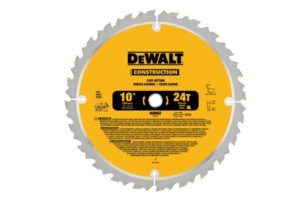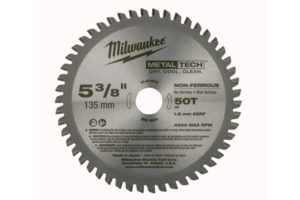
How to Choose the Best Blade for Circular Saws
Upgraded materials and recent improvements give Pros more and better circular saw blade options. Find out how to choose the best blade for circular saws.
By Peter Fabris
A circular saw is an indispensable workhorse for most contractors. Its portability and versatility to make different types of cuts on a wide variety of materials is unmatched. To get optimal performance out of the tool, though, choosing the best blade for circular saws from a wide variety of options is a must.

DeWalt Fast Cutting 10″ Circ Blade
Manufacturers offer blades designed for specific uses. Some are best for fast, rough cuts for jobs, such as lumber for framing. Other blades are designed to make fine, precise cuts for finish wood applications such as crown molding. Some blades are tailored for composite materials or cement fiberboard. High-end, diamond-coated blades can cut through just about any material with high durability.
Many factors should be considered when choosing the best blade for circular saws, so do your homework. It is worth the effort in order to get the blade type that offers the best performance and value. Regarding value, the lowest price doesn’t always equal the best deal in the long run.
Blade materials
Most circular saw blades are composed of three common types of cutting materials: steel, carbide tips, and polycrystalline diamonds. Blades made from other materials are for special uses. For example, the DeWalt 7 x 1⁄8-inch blade for metal cutting uses an aluminum oxide grain for the cutting surface. The most common blade types, by far, are the time-tested steel and carbide-tipped models.

Milwaukee Metal Tech 53⁄8″ Circ Blade
Steel blades are available in two categories: regular and high-speed. High-speed steel blades are harder than regular steel blades and stay sharper longer. Carbide blades have carbide tips attached to their teeth. They are more expensive than other blades, but they stay sharp much longer than steel or high-speed steel.
Carbide-tipped blades work well on wood but also excel at cutting other materials, including composite plastics and certain laminate products. The composition of carbide alloys used in saw blades varies in hardness. Cutting teeth made from harder carbide material are more durable, can cut harder material more easily, and are less likely to crack if dropped. Higher grade carbide models are typically more expensive, however.
Got teeth?
The number of teeth is an important factor to consider when choosing the best blade for circular saws for a particular task. On a 7¼-inch diameter blade – the most popular size for circular saws – tooth counts range from 24 to 80. Blades with fewer teeth have larger cutting elements than do ones with more teeth.

The metal core of the blade has been upgraded by manufacturers, which helps minimize vibrations. This makes for more accurate cuts by the user and a longer blade life.
“Blades with lower tooth counts cut faster and can do more, but you have to balance those advantages with the quality of the cut,” says David Brutscher, engineering manager, Stanley Black & Decker Inc., the company behind the DeWalt, Irwin and Porter Cable brands. Generally speaking, blades with higher tooth counts are meant for finer cuts with less tear out. These are appropriate for finish work on features, such as baseboards and crown molding. Lower tooth models are best for rough cutting materials, such as framing lumber, where speed and ease-of-use are more important than the quality of the cut.
Another blade type, Cermet, is a cemented carbide with titanium based hard particles. It is typically used to cut metal. These are effective and durable for metal cutting as they shroud the engine housing and provide containment for metal chips.
Polycrystalline diamond-coated models are versatile with the ability to cut just about any type of material including metal, tile and concrete. Diamond-coated blades may be a better value than other options, especially when cutting hard or abrasive material frequently.
“In general, you are going to get more cuts out of a single blade when compared to carbide, as high as 15 to 1 when cutting metal,” says Brian Delahaut, vice president, MK Diamond.
When you are working with highly abrasive material such as cement fiber board or laminate flooring, manufacturers recommend using diamond-coated blades. “Carbide won’t last long enough when cutting those materials,” Brutscher says, adding that diamond will outlast carbide for those uses by as much as 100 to 1.
A money saver
When you calculate the cost over time, it may well be worth paying more up front for a diamond blade. Delahaut points out that the cost of diamond blades has dropped by about 70 percent during the last 10 years, so the cost premium has been greatly reduced.
In addition, since diamond blades can cut any material, you don’t have to change blades for different cutting tasks. This can be particularly advantageous for plumbers, says Delahaut: “They can cut into a wall and cut through copper and galvanized steel pipe without having to change out the blade.”
Recent improvements
During the last several years, blade brands have incorporated advances in manufacturing and materials science into their products. For example, manufacturers are constantly tinkering with the alloys used in carbide tips to improve performance and durability. For a framing contractor who primarily cuts wood but encounters the occasional hidden nail when cutting lumber, high-grade carbide-tipped blades last longer than the carbide models from 10 or 15 years ago, says Todd Taylor, director of product marketing, accessories, for Milwaukee Tools.
The way the metal core of a blade, the non-cutting area, is made currently also has been upgraded by manufacturers. Lasers provide more precise cuts of steel. “This helps to minimize vibrations,” Taylor says, “which makes for more accurate cuts by the user and longer blade life.”
Manufacturers have also added different coatings to blade cores that diffuse heat better and minimize debris that accumulates on the blade. “This reduces heat buildup and gumming on the blade, resulting in a better cutting experience for the user and longer life for the blade,” Taylor says.
Choosing the best blade for your circular saw
Most contractors will want to have an inventory of at least a few different blade types for their day-to-day work before choosing the best blade for circular saws. A few key factors go into deciding which ones to buy. In addition to matching the blade with the material to be cut, you also need to pair the blade with the right circular saw.
“Blade diameter, arbor size and RPM need to align with what tool you plan to work with,” Taylor says. Manufacturers’ packaging contains charts to help buyers find appropriate blades for their needs.
Next, consider cost and value. Finding out if higher priced models are worth the expense for your work may require some trial and analysis. When it comes to quality and durability, “You get what you pay for,” Brutscher says. Still, there’s probably no need to buy the top-of-the-line carbide blade for a contractor primarily cutting softwood.
Maintenance tips
To extend the life of a blade, keep it clean using commercially available cleaners. This is especially important if you work frequently with sappy wood. Also, store blades carefully, so that the edges are protected if they are dropped. “All of our packaging is reusable for storage,” Brutscher says.
It’s usually pretty obvious when a blade needs to be replaced. It will be harder to push through a cut, excessive tear out will occur, and the blade may start to create burn marks on material or even produce smoke.
“Blades that have been damaged from misuse or abuse, especially if warped or missing teeth, should also be replaced,” Brutscher adds. To ensure safe use, contractors should wear safety glasses and implement appropriate dust control measures, especially when working in a confined space.
Properly maintained blades used for their recommended purposes should produce good cuts with good durability. Choose the right blade for the job, and even the most versatile saw should last many years.

